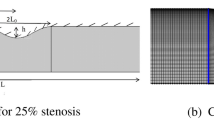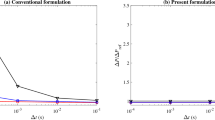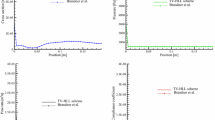Abstract
A high-order solver for the blood flow is developed and analyzed using a two-dimensional backward-facing step. In the first part, a Newtonian steady code to solve the incompressible Navier–Stokes (N–S) equations has been developed. The accuracy of the code is verified by comparing the results to the experimental results. An exact projection method/fractional-step scheme is used to solve the incompressible N–S equations. Convective terms of the N–S equations are solved using fifth-order WENO spatial operators, and for the diffusion terms, a sixth- order compact central difference scheme is employed. The third-order Runge–Kutta (R–K) explicit time-integrating scheme with total variation diminishing (TVD) is adopted for time discretization. In the second part, the pulsatile behavior of the Newtonian blood flow has been added to the initial program. Thirdly, the numerical code has been extended to include the steady and pulsatile effects in non-Newtonian blood flow. Finally, a practical example of bend tube has been analyzed by extending the two-dimensional code to 3D and the results are compared to already published data.





















Similar content being viewed by others
References
Fahraeus R, Lindquist R (1931) Viscosity of blood in narrow capillary tubes. Am J Physiol 96:562–568
Denning A, Watson J (1900) The emergence of rheology. Phys Today 21:23–30
Brecher GA (1956) Venous return. Grune and Stratton, New York
Whitmore RL (1968) Rheolgy of the circulation. Pergamon Press, Oxford
Schmid-Schonbein H (1976) Microrheolgy of erythrocytes, blood viscosity, and the distributions of blood flow in the microcirculation. International review of physiology, cardiovascular physiology II, Vol. 9. University Park Press, Baltimore
Cokelet GR, Meiselman HJ, Brooks DE (1980) Erythrocytes mechanics and blood flow. Alan R. Liss, New York
Dintenfass L, Seaman GVF (1981) Blood viscosity in heart disease and cancer. Pergamon Press, Oxford
Pries AR, Neuhaus D, Gaehtgens P (1992) Blood viscosity in tube flow: dependence on diameter and hematocrit. Am J Physiol 263:H1770–H1778
Liepsch D, Kamada T, Poll A, Moravec S (1994) Two-phase flow measurements in glass tube models with a laser-Doppler-anemometer. In: Hosoda S, Yaginuma T, Sugawara M, Taylor MG, Caro CG (eds) Recent progress in cardiovascular mechanics, Harwood Academic Publishers, Switzerland
Haynes RH, Burton AC (1959) Role of the non-Newtonian behaviour of the blood in hemodynamics. Am J Physiol 197:943–950
Atabek HB, Chang CC, Fingerson ML (1964) Measurement of laminar oscillatory flow in the inlet length of a circular tube. Phys Med Biol 9:219–227
Attinger EO, Sugawara H, Navarro A (1966) Pulsative flow methods sin distensible tube. Circ Res 18:447–456
Muller A (1954) Uber die Verwendung des Pitot-Rohreszur Geschwindigkeitsmessung. Helvetica Physiologica Acta 12:98–111
Freis ED, Heath WC (1964) Hydrodynamics of aortic blood flow. Circ Res 14:105–116
Zhu C, Li X, Lin H, Zhong Z (2007) Geometric modeling and numerical simulation of the blood flow in human arterial system. In: Proceedings of the 2007 IEEE International conference on Robotics and Biomimetics
Babak H, Sadeghipour MS (1994) Numerical analysis of the pulsative blood flow in deformable vessels. Curr Dev Numer Simul Flow Heat Transf 275:141–148
Lee SW, Smith DS, Loth F, Fisher PF, Bassiouny HS (2007) Numerical and experimental simulation of transitional flow in a blood vessel junction. Numer Heat Transf 51:1–22
Noguchi Y, Wishah MI (2003) Three-dimensional CFD modelling of blood flow through asymmetric stenosis. Comput Methods Exp Meas 4:567–574
Dabiri Y, Fatouraee N, Katoozian H (2005) A computer simulation of blood flow in arterial networks, including blood non-Newtonian methods and arterial stenosis. In: Proceedings of the 2005 IEEE Engineering in Medicine and biology Annual Conference, Shangai, China
Rudman M, Blackburn HM (2006) Direct numerical simulation of turbulent non-Newtonian flow using spectral element method. Appl Math Model 30:1229–1248
Naghavi MR, Navidbukhsh M (2005) Non-Newtonian behaviour of blood flow in 3D simulated model of carotid artery bifurcation. In: Proceedings of the 14th IASTED International Conference Applied Simulation and Modelling, Benalmadena, Spain
Cole JS, Gillian MA, Raghunathan S (1999) Numerical simulations of time-dependent, non-Newtonian blood flow through typical human arterial bypass grafts. Dev Chem Eng Miner Process 7:179–200
Politis AK, Stavropoulos GP, Christolis MN, Panagopoulos FG, Vlachos NS, Markatos NC (2007) Numerical modelling of simulated blood flow in idealized composite arterial coronary grafts: steady state simulations. J Biomech 40:1125–1136
Podyma M, Zbicinski I, Walecki J, Nowicki ML, Andziak P, Makowski P, Stefanczyk L (2006) Numerical analysis of blood flow in human abdominal aorta. Adv Fluid Mech 52:603–611
Egelhoff CJ, Budwig RS, Foster JK, Hansen BL (2001) Investigation of coronary artery stenosis hemodynamics using experimental and computational models: influence of flow rate, size symmetry and wall roughness. In: Proceedings of 2001 ASME International Mechanical Engineering Congress and Exposition
Shu CW, Zang TA, Erlebacher G, Whitaker D, Osher S (1992) High order ENO schemes applied to two- and three- dimensional compressible flow. Appl Numer Math 9:45–71
Chorin AJ (1968) Numerical solutions to Navier–Stokes equations. Math Comput 22:745–762
Kim J, Moin P (1984) Application of a fractional-step method to incompressible Navier–Stokes equations. J Comput Phys 59:308–323
Shu CW, Osher S (1988) Efficient implementation of essentially non-oscillatory shock capturing schemes. J Comput Phys 77:439–471
van de Vosse FN (1987) Numerical analysis of carotid artery flow. Technische Universteit Eindhoven, Eindhoven
Truskey GA, Barber KM, Robey TC, Oliver LA, Combs MP (1995) Characterization on a sudden expansion flow chamber to study the response of endothelium to flow recirculation. J Biomech Eng 117:203–210
Gijsen FJH (1998) Modeling of wall shear stress in large arteries. Technische Universteit Eindhoven, Eindhoven
Armaly BF, Durst F, Pereira JCF, Schonung B (1983) Experimental and theoretical investigation of backward facing step flow. J Fluid Mech 127:473–496
Choi HW, Barakat AI (2005) Numerical study of the impact of non Newtonian blood behavior on flow over a two dimensional backward facing step. Biorheology 42:493–509
Blackburn HM, Sherwin SJ (2007) Instability modes and transition of pulsatile stenotic flow: pulse period dependence. J Fluid Mech 573:57–88
Author information
Authors and Affiliations
Corresponding author
Rights and permissions
About this article
Cite this article
Khurshid, H., Hoffmann, K.A. Development of a high-order solver for blood flow. Engineering with Computers 31, 51–71 (2015). https://doi.org/10.1007/s00366-013-0324-z
Received:
Accepted:
Published:
Issue Date:
DOI: https://doi.org/10.1007/s00366-013-0324-z




